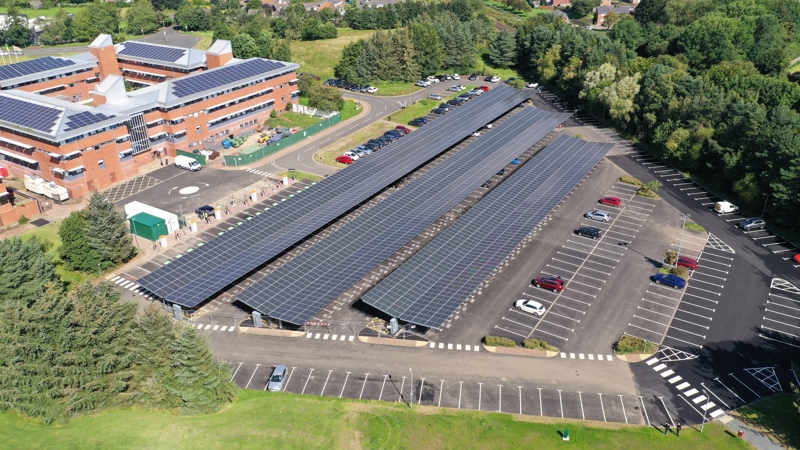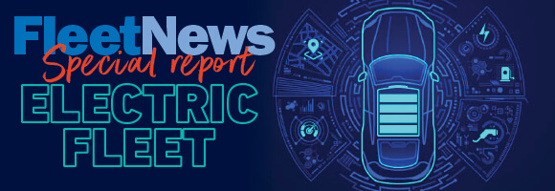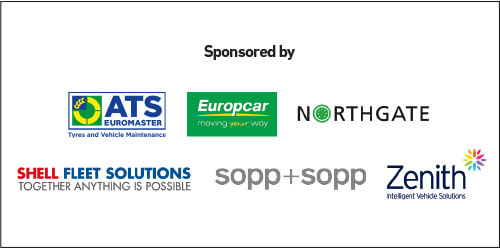This feature was taken from our latest Electric Fleet report. Click here to read it.

One of the oft-heard criticisms of electric vehicles (EVs) is that, although they may be zero emission at the tailpipe, millions of tonnes of CO2 is created during the generation of their energy.
While there is some truth in this given that huge amounts of fossil fuels are burnt by power stations, an increasing amount of electricity is generated through zero-emission sources.
Last year, for example, figures from the Department for Energy Security and Net Zero showed that more came from renewable and nuclear power sources than from fossil fuels – after gas (38%), wind was the second largest source of electricity at 25%. Solar, hydro and marine were at 6%.
While organisations can opt for a green energy electricity tariff to improve their sustainability, an increasing number are installing solar arrays at their premises.
As well as generating the power to charge their EVs themselves, this also means the organisations can cut costs.
One example of this is City of Doncaster Council. It estimates it will save approximately £33,633 in electricity costs each year through a 20-space car park covered by a solar panel roof.
This facility, which is close to its Civic Office in Waterdale, will generate an average of 88,510kWh each year, have 10 dual-socket charge points and be home to 20 of the council’s electric pool cars.
Even taking into account the £658,798 cost of construction, it expects to make an overall saving of £180,000 over the typical life expectancy of 25 years for such a facility.
Battery storage
Combining solar arrays with batteries to create a battery energy storage system (BESS) unlocks another level of usability.
These act like a reservoir to store electricity generated during quiet times, either from on-site renewables or the grid, and delivers that power during peak periods.
The reason battery storage systems are so useful is down to the intelligent control systems that can solve several problems for businesses, says Matthew Lumsden, founder and CEO of Connected Energy, which is a leading provider of BESS to the fleet and EV charging sectors.
"They can help support a fleet’s decarbonisation goals, reduce energy bills and enable fleets to accelerate their electrification plans,” he adds.
“This technology is going to become increasingly relevant as fleets move towards mass adoption of EVs.”
North Tyneside Council installed a BESS after recognising it would be giving 15% of the energy created by its state-of-the-art solar car port array at its Killingworth site back to the grid.
“In the first three months since installing and commissioning the solar array in February 2023, we generated more than 100,000kW of green energy,” says Ian Lillie, strategic facilities manager for North Tyneside Council.
“However, we had to give back more than 20,000kW to the grid because we couldn’t store it.
“By using BESS, we can capture that energy and use it to charge our electric vans and, indeed, power the buildings on site overnight.
“And in the winter, we can use it to store energy from the grid on lower tariffs at night, to use during the day.
“The combination of solar and BESS should significantly reduce our electricity bills while also cutting carbon emissions from our energy consumption.”
The solar array, installed as part of a multi-million pound project supported by the European Regional Development Fund, is capable of developing 700kW of electricity at peak times, generating around 600,000kWh each year.
The energy will be used to power the building and facilities as well as charge the council’s electric vehicles. More than 40 chargers are being installed.
Accelerate fleet electrification
Installing a BESS can also help accelerate fleet electrification. Numerous organisations face grid capacity issues as in many places the infrastructure to support banks of EV charge points is not sufficient.
One solution is to have a site’s connection to the grid upgraded, and although fleets are no longer liable for the potentially huge cost of this due to new Access SCR regulations, there are long waiting lists for DNO upgrades.
“A BESS can be a much quicker route to the extra power needed to deploy the next wave of EV charging infrastructure,” says Lumsden.
He adds it can also aid organisations with ‘peak shaving’, which is the industry name for reducing spikes in energy demand on the grid.
For fleets, these spikes are increasingly higher due to larger numbers of EV chargers.
This was a key issue for Nottingham City Council when it installed a BESS at its fleet depot, which is home to around 20 vehicles.
The depot includes 40 vehicle-to-grid (V2G) bi-directional chargers with three solar arrays to give a combined generation of 176kW. It also has two 300kWh energy storage systems.
“By using intelligently managed BESS and V2G, on-site solar energy can be maximised and the depot will effectively be able to isolate itself from the grid,” says Steve Cornes, principal energy projects officer at Nottingham City Council.
“The system will allow us to ensure production costs of electricity will be negligible, allowing us to peak shave so we can avoid high electricity tariffs and give us the opportunity to trade electricity back to the grid.”
While many battery storage systems are connected to solar array, they still have many advantages if they are standalone units, including potentially avoiding the need for grid upgrades, and helping with peak shaving.
Used this way, they can also help an organisation reduce its energy bills. The BESS can buy energy from the grid on off-peak tariffs, then provide it to charge points during peak times.
“This becomes even more relevant if those spikes in demand are leading you to exceed your maximum import capacity (MIC),” says Lumsden.
Sometimes also referred to as a kVA allowance, MIC is the limit on how much electricity you can take from the grid.
These limits exist because business premises are often on a shared grid connection, so they prevent a depot from using too much power at the expense of its neighbours.
“If you breach your MIC due to too many EVs charging at once, you will face surcharges on your energy bills.
“In these cases, a BESS can be a cost-effective alternative,” adds Lumsden.
Second-life batteries
An organisation can further enhance its environmental credentials by installing a BESS which uses second-life batteries.
These often come from EVs which have reached the end of their life with the batteries typically retaining up to 80% of energy storage capabilities.
“Those that are too degraded for second-life applications can be recycled, but analysts estimate this will be a relatively small number – around 15%,” says Lumsden.
“The remainder are still robust enough to be repurposed in another energy storage application.”
Market analysts McKinsey estimate than in 2025 there will be 800 million tonnes of EV batteries ending first-life applications. This will increase in the future, mirroring the EV adoption curve.
“The potential for positive environmental impact by reusing as many of these batteries as possible is enormous,” says Lumsden.
“In 2025, 800m tonnes amounts to circa 90m MWh of second-life battery capacity.
“Assuming that even 25% of these batteries are reusable, that could deliver estimated savings of 10,1250m tonnes of CO2 compared with using first-life batteries.
“We commissioned research which found that our systems can provide a positive carbon benefit of 450tCO2e for every 1MWh installed, compared with a BESS fitted with brand new batteries.
“So, if a fleet is serious about decarbonisation, using second life systems makes much more sense.
“There is a huge potential for this technology to take fleet depots off grid entirely in the future.
“And there is a neat circularity about batteries from yesterday’s EVs helping to power the EVs of tomorrow.”

Our latest Electric Fleet special report will help organisations take the next step to fully decarbonise their fleets, including:
- The new rules which slash EV charging infrastructure costs for fleets
- Importance of looking after charging cables
- Increase EV sustainability with a battery energy storage system
- Learnings from a wireless charging trial
- Electric vehicles coming soon





















Login to comment
Comments
No comments have been made yet.